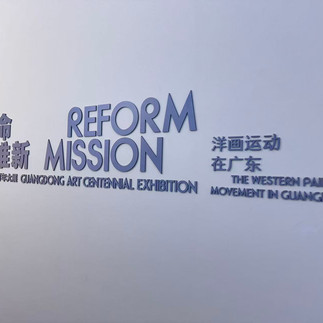China Art Museum
- Cathy Shen

- 3 days ago
- 4 min read
China Art Museum, located at 205 Shangnan Road, Pudong New Area, Shanghai, has as its main building the China Pavilion "Oriental Crown" from the 2010 Shanghai World Expo. The building stands 63 meters tall with a total floor area of 166,800 square meters. Inspired by the traditional "dougong" (bracket set) structure, it features a red layered seal-script exterior, embodying the theme of "Oriental Ceremony, Flourishing China." On October 1, 2012, it was renamed "China Art Museum" and merged with the Shanghai Art Museum.
China Art Museum has nearly 70,000 square meters of exhibition space, divided into 6 exhibition levels and 35 exhibition halls. The museum houses 14,000 pieces in its collection, categorized into Chinese paintings, oil paintings, calligraphy, prints, sculptures, shadow puppets, and more.
During my visit, the China Art Museum had four main themed exhibitions: the 60-meter level (12F), 49-meter level (10F), and 41-meter level (8F) featured the Guangdong Art Centennial Exhibition themed "Reform Mission"; the 1st floor had three exhibitions: "Magnificent China—30 Years of China Oil Painting Society Art Exhibition," "People's City—Shanghai Themed Art Works Achievement Exhibition," and the "Da Vinci—Wheel of Time" VR experience exhibition. The "30 Years of China Oil Painting Society Art Exhibition" also occupied exhibition halls on the B2 level.
The current highlight exhibition is "Reform Mission," which is jointly organized by the Guangdong Museum of Art, the Shanghai Art Museum, and the Guangdong Artists Association. The exhibition runs from October 18, 2025, to January 18, 2026. The exhibition showcases over 800 works created by Cantonese artists since the early 20th century. These works include Chinese paintings, oil paintings, prints, cartoons, watercolors, sculptures, and visual media. The subjects include traditional Chinese landscapes, figures, and birds-and-flowers, as well as modern themes that reflect contemporary characteristics and local features. There are exhibition halls for case studies on Guan Shanyue and Li Xiongcai, as well as themed exhibitions on Guangdong's "Westernization Movement," "Lingnan School and Chinese Painting Research," and "New Woodcut Movement."
"Westernization Movement" and Lingnan School
Guangdong, one of China's earliest regions to embrace maritime civilization, has a 4,000-kilometer coastline that served as a corridor for Chinese and foreign artistic fusion. Over 400 years ago, when Matteo Ricci brought European paintings through Macau, he and his companions encountered Xinhui's "wooden beauty" oil paintings, which planted the seeds for East-West artistic dialogue. The "wooden beauty" also became the earliest surviving oil painting artifact in China.
The Guangdong art Westernization Movement primarily refers to the process of learning and integrating Western art within Guangdong's art circles from the late 19th to early 20th century. Led by the Lingnan School, this movement promoted the modern transformation of Chinese painting. The founders of the Lingnan School—Gao Jianfu, Gao Qifeng, and Chen Shuren—studied in Japan and Europe during the early 20th century, where they systematically learned Western painting techniques and art theory. After returning to China, they established "New Chinese Painting," advocating for the synthesis of Chinese and Western styles while blending ancient and modern techniques. During the early Republic era, the Lingnan School established a tripartite balance with the Beijing and Shanghai schools, thereby occupying an important position in modern Chinese art history.
Artistic Characteristics:
Technical Innovation: The Lingnan School absorbed Western perspectives, light and shadow techniques, and color methods to transform traditional brushwork. For example, Gao Jianfu's "Flames of the Eastern Battlefield" merged oil painting techniques with Chinese painting aesthetics. They employed techniques such as the "boneless method" and the "water-powder collision method" to enhance the three-dimensionality and realism of their artwork.
Subject Matter Breakthrough: This movement shifted from traditional literati painting to real life, effectively expressing social transformation. For instance, Lin Fengmian's "Lady in Blue" combines Western colors with classical Chinese aesthetics, while Guan Liang's paintings of opera characters incorporate elements of Western expressionism.
Historical Impact
This movement established Guangdong as one of the birthplaces of Chinese art modernization. IIts "open and inclusive" artistic DNA directly influenced the development of subsequent Shanghai School art and provided a historical reference for contemporary artistic innovation.
Representative Figures
• The founders of the Shanghai School include Gao Jianfu, known for his representative work "Flames of the Eastern Battlefield"; Gao Qifeng, recognized for "Autumn Eagle"; and Chen Shuren, famous for "Pale Yellow Willows Dancing in Spring Wind."
• The second generation of masters includes Guan Shanyue, Li Xiongcai, Zhao Shao'ang, and Yang Shanshen; they are collectively known as the "Four Masters of the Contemporary Lingnan School." They made further breakthroughs in their art while inheriting traditions, exemplified by Li Xiongcai's "Li Family Landscapes" and Guan Shanyue's "Green Great Wall."
The 1st floor and B2 level of the China Art Museum also feature the "30 Years of Chinese Oil Painting Art Exhibition," which is organized by the China Oil Painting Association, China Academy of Art, Central Academy of Fine Arts, and Shanghai Art Museum. The exhibition is divided into four themes: "Epic Grandeur—30 Years Comprehensive Section," "People's Spirit—Portrait Section," "Mountain and River Views—Landscape Section," and "Nature's Expression—Abstract Still Life Section." This exhibition commemorates the 30th anniversary of the China Oil Painting Association by reviewing the development of Chinese oil painting and showcasing representative works from various periods, as well as contemporary oil paintings.
At the China Art Museum, all other exhibitions are free, except for the "treasure of the museum"—the 3D display of "Along the River During the Qingming Festival," which charges an admission fee of 20 yuan. Viewing all exhibitions requires at least 4 hours.







































Comments